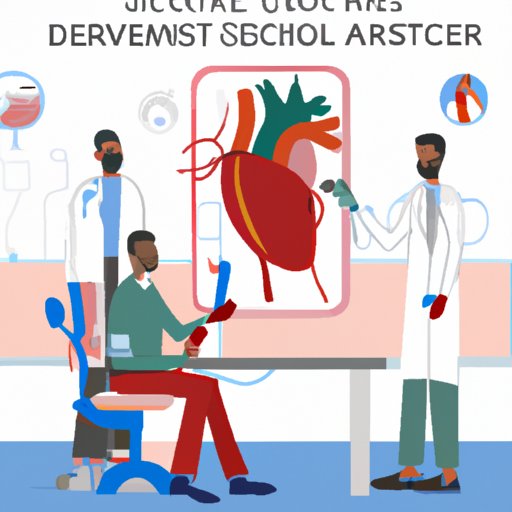
Introduction
Peripheral artery disease (PAD) is a common medical condition that affects millions of people every year. PAD occurs when there is a reduced blood flow to the limbs, usually due to narrowed or blocked arteries in the legs. This condition can cause pain, numbness, and difficulty walking, which can significantly impact one’s quality of life. Finding the right medical professional for PAD treatment is crucial, as it can make all the difference in a patient’s recovery and overall well-being.
Peripheral Artery Disease 101: Understanding the Specialists Who Can Offer Treatment
There are several types of medical specialists who can diagnose and treat PAD. These include vascular surgeons, interventional cardiologists, interventional radiologists, and podiatrists.
Vascular surgeons are medical doctors who specialize in the diagnosis and treatment of vascular disease, including PAD. They have extensive experience in performing surgeries and other procedures to treat the condition. Interventional cardiologists are specialized cardiologists who concentrate on the diagnosis and treatment of heart-related disorders and procedures. They employ minimally invasive techniques such as angioplasty, arterial stenting, and atherectomy to treat PAD. Interventional radiologists are doctors who specialize in diagnosing and treating medical conditions using imaging guidance, including PAD. They use minimally invasive techniques to treat the condition, such as angioplasty and stenting. Podiatrists are foot doctors who specialize in treating foot and ankle problems, including those caused by peripheral artery disease.
Each specialist has specific qualifications and expertise in the diagnosis and treatment of PAD. Vascular surgeons, for example, undergo extensive surgical training and have significant experience in open vascular surgical procedures and endovascular procedures that treat the condition. Interventional cardiologists and interventional radiologists have specialized training in using minimally invasive techniques to diagnose and treat PAD. Podiatrists, on the other hand, focus on treating foot and ankle problems, including those resulting from PAD.
The role of each medical specialist in the diagnosis and treatment of PAD varies. Vascular surgeons, for example, may perform open vascular surgery or endovascular procedures to improve blood flow to the affected area. Interventional cardiologists and interventional radiologists may use minimally invasive procedures to widen or clear the blocked arteries. Podiatrists may offer nonsurgical treatments, such as medications, exercise, and lifestyle changes, to manage the symptoms of PAD.
Navigating Diagnosis and Treatment for Peripheral Artery Disease: Which Doctor Is Best for You?
Choosing the right doctor for PAD treatment can be a daunting task for many patients. Factors to consider include the doctor’s experience and expertise, the location and accessibility of the medical facility, and the cost of the treatment.
During the diagnostic process for PAD, doctors will typically perform a physical exam and a series of diagnostic tests to evaluate the patient’s symptoms. These tests include ankle-brachial index, a Doppler ultrasound, and an angiogram. It’s essential to talk to your doctor to understand what to expect during the diagnostic and treatment process and how to prepare for the diagnostic tests.
Behind the Scenes: A Look at the Doctors Working to Cure Peripheral Artery Disease
Medical research conducted in recent years has resulted in significant advancements in PAD treatment. Researchers are continually discovering new ways to diagnose and cure the condition. Additionally, doctors collaborate with each other to develop the best treatment plan for each patient.
Many patients who have received treatment for peripheral arterial disease have experienced excellent outcomes and significant improvements in their quality of life. Some medical facilities offer patient support groups for those affected by PAD, which can provide a supportive environment and resources for patients undergoing treatment.
Treating Peripheral Artery Disease: Which Medical Professional Fits Your Needs?
There are several medical professionals involved in the treatment of peripheral artery disease, including vascular surgeons, interventional cardiologists, interventional radiologists, podiatrists, and other healthcare professionals. When selecting a medical professional for PAD treatment, it is essential to consider the medical professional’s role in diagnosis and treatment, the degree of expertise, and the treatment options available.
Vascular surgeons, interventional cardiologists, and interventional radiologists, for example, may offer minimally invasive procedures to manage the symptoms of PAD. Podiatrists may provide nonsurgical treatments such as medications, lifestyle modifications, and exercise. Other healthcare professionals involve primary care physicians, physical therapists, and nutritionists.
Conclusion
Peripheral artery disease can cause significant impairments in one’s quality of life, which is why seeking medical care for PAD is essential. Choosing the right doctor can make all the difference in a patient’s recovery. With the advancements in PAD research, there are several medical professionals who specialize in diagnosing and treating this condition. Through collaborative efforts, medical professionals work together to develop the best treatment plan for each patient. By taking control of their health and choosing the right medical professional, patients with PAD can experience significant improvements in their quality of life.




